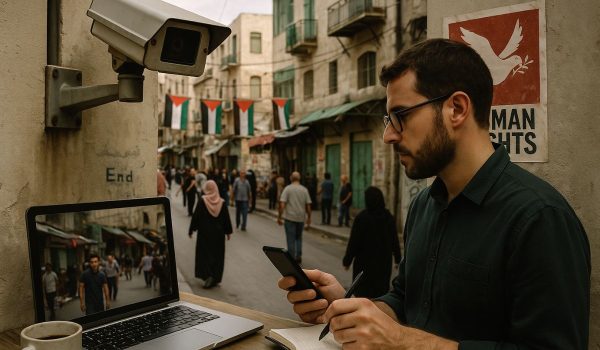Cameras on every corner. Drones overhead. Facial recognition software scanning public spaces. Surveillance technology is expanding fast, often faster than laws can keep up. While it can be used for safety and monitoring public areas, it also raises deep concerns about civil rights and personal freedom.
For communities already living under pressure, such as Palestinians in the West Bank or immigrants in detention centers, these technologies are not just tools—they’re systems of control. Understanding how surveillance works, and how it affects daily life, is the first step in defending rights and creating better protections for everyone.
What This Article Covers About Surveillance and Rights
This article looks at the rise of surveillance technology and its impact on civil rights. It focuses on how this technology is used, who it affects most, and how communities are responding.
You’ll read about real-life examples of how surveillance systems work in occupied territories, cities, and border zones. The article also shares ways legal advocates, activists, and communities are working to hold these systems accountable and protect basic freedoms.
How Surveillance Has Changed
Surveillance is not new. Governments have always tried to watch and control information. But modern technology has made it faster, quieter, and harder to detect. Cameras are smaller. Data is stored longer. Software can recognize faces, track movements, and predict behavior.
This creates a situation where people may be monitored without ever knowing. In some cases, cameras are visible. In others, the surveillance is silent—happening through mobile phone data, online activity, or license plate tracking.
What makes this shift serious is that people can be watched simply because of where they live, how they look, or what language they speak. Without strong rules, surveillance becomes a tool for discrimination and control.
The Palestinian Context
In Palestine, surveillance is more than a security measure—it is part of the daily experience of occupation. Cameras are installed at checkpoints, on rooftops, and in neighborhoods. Drones monitor protests. Biometric scanners collect data from workers crossing into Israel.
Technology firms, often from other countries, provide systems that track and monitor Palestinians. These systems are sold as security solutions, but their use often goes beyond defense. They create an environment where people are watched at all times, limiting freedom of movement, expression, and even routine daily life.
In some neighborhoods, people report avoiding protests or public gatherings simply because they fear being recorded. This leads to self-censorship and social fear—both signs of restricted civil space.
Civil Rights and Data Collection
At the heart of the issue is consent. Who agrees to be watched? Who controls the data? In many communities, surveillance technology is installed without notice or discussion. People’s faces, voices, and routines are collected, analyzed, and stored.
This raises questions about privacy and ownership. Who has the right to keep data on someone’s face or movement? How long is it kept? What happens if it’s misused or stolen?
For marginalized groups, these concerns are serious. A protestor identified by facial recognition may face arrest. An undocumented worker tracked by phone data may face detention. These technologies do not exist in a vacuum—they reflect and amplify existing power structures.
Impact on Freedom of Expression
Being watched changes how people act. Studies show that when people think they are under surveillance, they are less likely to express unpopular opinions, attend protests, or speak freely. This effect is not just psychological—it shapes politics, activism, and public life.
For legal advocates and journalists, this has real consequences. Protecting sources, speaking with vulnerable clients, or even organizing a legal defense becomes more difficult when surveillance is constant. People begin to self-limit not because they are guilty, but because they are afraid of being seen.
This kind of chill affects civil society deeply. It stops conversations before they begin and weakens democratic engagement.
Legal and Ethical Responses
Some countries and cities are starting to push back. Bans on facial recognition software, rules about body cameras, and strict guidelines for data storage are slowly emerging. But enforcement is uneven, and private companies still have wide freedom to sell and test products with little oversight.
In Palestine, legal advocacy groups are working to document and challenge surveillance practices that violate international human rights. This includes research, legal filings, and public campaigns. While the path is difficult, even small wins—like forcing transparency or stopping a new system from being deployed—can create space for resistance.
Global networks are also forming to monitor the use of surveillance across borders. These groups share tools, strategies, and legal arguments that help build stronger cases for accountability.
Grassroots Resistance and Community Awareness
Beyond the legal system, communities are organizing to resist surveillance in their own ways. In some cities, residents place stickers on facial recognition cameras. Others create art or music that responds to constant monitoring.
Workshops teach people how to protect their data and recognize surveillance patterns. Activists share guides on how to block or confuse facial recognition tools. These actions may seem small, but they build a culture of awareness and empowerment.
People are also asking hard questions about what safety really means. Is safety the same as security? Can communities be protected without being watched? These conversations are important—and they help shift public expectations.
Building a Future with Rights in Mind
Technology will keep moving forward. New systems will emerge, offering more ways to track, store, and analyze human behavior. But technology itself isn’t neutral—it reflects the values of those who build and use it.
If people want a future where rights are respected, they need to be part of the conversation now. That means asking questions, setting boundaries, and demanding accountability. It also means centering the voices of those most affected—like Palestinians living under occupation or communities already facing discrimination.
Surveillance technology may be silent, but its impact is loud. It shapes how people live, speak, and move through the world. Protecting civil rights means paying attention to these systems, questioning their use, and standing up for dignity in every space—public or private.

